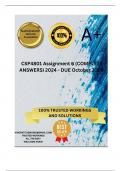,CSP4801 Assignment 6 (COMPLETE ANSWERS) 2024 -
DUE October 2024 ; 100% TRUSTED Complete, trusted
solutions and explanations.
Question 1 Many psychologists believe that one of the most
important stages of cognitive development is symbolic play.
You have been given a task to help a group of parents to
understand symbolic play. In ten (10) points, explain in what
way the quality of children’s symbolic play can have
consequences on the children’s later development. Include
examples that are relevant to the group of parents you are
speaking to. Indicate the age of the learners that you are
referring to. (20)
Here are ten points that explain how the quality of children's
symbolic play can impact their later development, specifically
for preschool-age children (ages 3-5):
1. Cognitive Development
• Explanation: Symbolic play fosters cognitive growth by
enabling children to understand abstract concepts and ideas.
• Example: When a child pretends a banana is a phone, they
begin to grasp that objects can represent something else,
enhancing their reasoning skills.
2. Language Skills
, • Explanation: Engaging in symbolic play encourages
vocabulary development and language use as children
narrate their play scenarios.
• Example: A child playing house might use phrases like
"Let's cook dinner," which helps expand their vocabulary
and sentence structure.
3. Social Skills
• Explanation: Through cooperative play, children learn to
negotiate, share, and collaborate, which are critical skills
for social interaction.
• Example: If two children pretend to be doctors, they
practice taking turns and listening to each other’s ideas,
fostering teamwork.
4. Emotional Understanding
• Explanation: Symbolic play allows children to explore
emotions and develop empathy by acting out various roles
and situations.
• Example: A child might play as a caregiver to a doll,
practicing nurturing behaviors and understanding feelings
of others.
5. Problem-Solving Skills
• Explanation: In symbolic play, children often encounter
challenges that require them to think critically and devise
solutions.
• Example: While building a fort with blocks, a child might
need to figure out how to balance the structure to prevent it
from collapsing.




